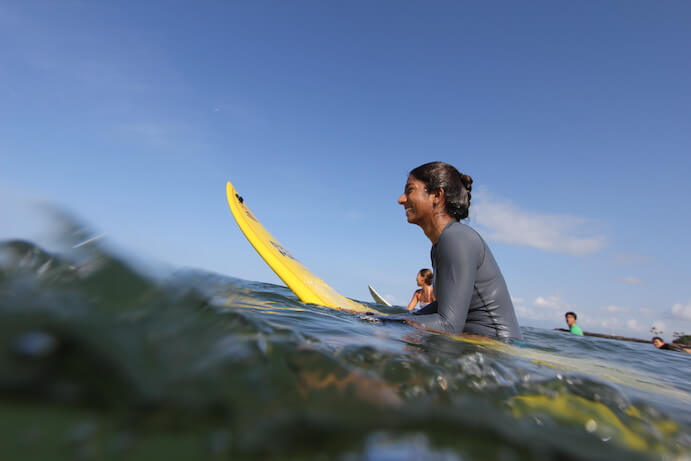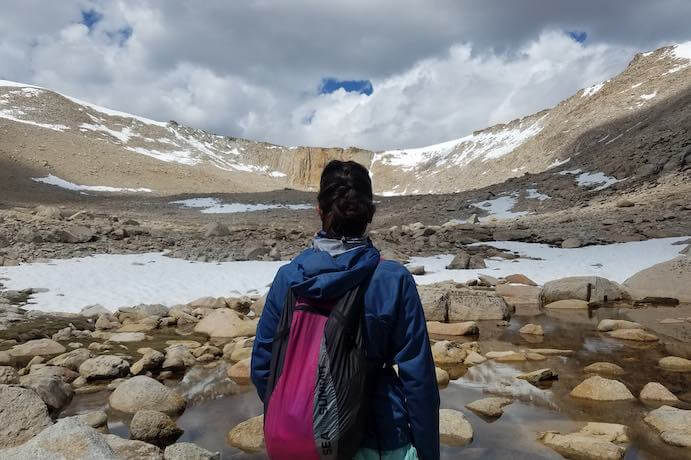There are views you don’t forget: that first, perfect glimpse to the other side of a mountain pass; canyons closing in around you as you descend through tighter and tighter slots; paddling out through mountains of rising waves and churning, powerful, writhing salt water all around you.
There are sounds you don’t forget: the howling wind between the nooks of a rock precipice; the magic almost-silence of sinking through a cloud of mobula rays; the tremendous roar of a wave breaking behind you as you fly down and across its face.
My memories are filled with sights, sounds, and smells from the wild that have shaped my worldview, inspired my music, and centered me as an artist and a person. For the last two decades, I have grounded my music-making in my experiences as a hiker, runner, surfer, and diver, and in the tremendous beauty I have had the privilege of witnessing outdoors.
I thought this was a defining element of my life — that whatever else may change or fall apart, I could go to the water or the trails and find peace, perspective, and inspiration. And I always thought the resilience I learned outdoors would be the best preparation for whatever challenges in life were to come. I’ve pushed through grueling, unforgiving days in the mountains. I’ve gotten lost alone in deep canyons and needed to find my way out before running out of water. I’ve spent freezing nights in hail storms, lightning storms, and dust storms, and thrived on the challenges. I thought I had a deep understanding of what resilience was.

Juhi Bansal surfing — Photo courtesy of the artist
But I’ve learned in the last year that there are different kinds of resilience. At the end of 2022, I was diagnosed with damage to my cervical spine — degenerative disease, chronic overuse, herniated discs, bony growths, stenosis — a kitchen sink of the many ways a spine can go wrong. The prognosis from multiple doctors is that I won’t be able to walk for long distances ever again; I won’t be able to surf, carry a backpack, or return to sport in any meaningful way. I’ve spent the last two decades traveling, surfing, and hiking around the world every moment I wasn’t at work, often with my partner, but more often alone — proud to test my limits and get to see things that few people experience. I know that life could easily be filled with much greater losses, but it has nonetheless felt shocking and traumatic.
In the space of a year and a half, much of what I centered my identity around has vanished — subsumed by a fog of pain and uncertainty, of dead ends and treatments that haven’t worked, of worries about money, relapse after relapse, and seething frustration. And I’ve had the eye-opening experience of learning to live with physical limitations that others don’t see. This is a new landscape for me, one filled with voices telling me all of the things that will be impossible, rather than all the things to strive for. I try to focus on the tiny threads of optimism and the rare voices promising that things can still improve, even though they’ve been wrong so far.
When I pictured resilience in the past, I imagined something that rewards you on the other side of a challenging experience with something new: grueling days of climbing that gift you views from the top of a mountain pass, violent storms that leave vistas of the valley in their passing, tough paddles through heavy surf that result in soaring waves that make you feel like you’re flying.
It takes determination to believe in our worth as artists, to believe that our work is beautiful or interesting or powerful in those moments when no one else is listening yet.
With this injury and this diagnosis, suddenly “resilience” seems to demand something much harder: the ability to persevere through each day without obvious reward, where the payoff is just…another day. How do we keep moving forward when things feel hopeless? I always thought you put your head down and just keep pushing through, but what do you do when that’s simply not possible anymore?
I used to think that the lessons of the outdoors had given me a stubbornness that allowed me to survive as a musician, but now I wonder if I was looking at the picture backwards all along. Through this past year, I’ve come to deeply appreciate the quieter value of artistic resilience, and the way it underpins so much of our lives — almost unnoticeably.
There’s toughness demanded in sharing our work with the world in the face of rejection and indifference. It takes determination to believe in our worth as artists, to believe that our work is beautiful or interesting or powerful in those moments when no one else is listening yet. We commit ourselves to a path and walk it even when the goal is unclear, success is uncertain, and the landscape is shifting and unstable around us. Our reward, at its height, is moments of shared joy, beauty, and celebration — but more often, it’s something much simpler and quieter: just another day or season of being in the world making music.
Juhi Bansal composing at the piano — Photo courtesy of the artist
As artists, we practice resilience every day. We hold our ideas alone in our minds until they become something others can experience. We push through rejection, fluctuating income, limited opportunities, competition, and a technological and aesthetic landscape that moves faster than we can. We balance conflicting dreams and desires as we build our lives and families around music, carefully choosing where and what to sacrifice. We select cities, homes, and jobs to facilitate our art. We negotiate time, space, and money for music around other priorities, around family and day jobs and other commitments. But we don’t talk about the sacrifices often, at least not in public, even though the challenges and the resilience we need to overcome them are as integral to being an artist as the art itself.
I begin this year reminded of what it takes to do something as simple as hope; reminded of the landscape of obstacles we each navigate, unseen, just to keep moving forward one step at a time. There are no awards for persevering through one more day of pain, for writing a piece of music that lives only in your hands, for playing or singing something of sublime beauty that no one else hears. I wish these moments were recognized to help us hold faith in moments of uncertainty, so we can be reminded that our work, our efforts, and our striving have intrinsic value.
Culturally, we place such outsized importance on overcoming, as if the before and the during have no value at all until placed beside a cheerful, smiling photo of an after. But that so deeply undervalues the perseverance it takes to simply not give up as we each traverse our individual difficulties and losses, whether in music or something larger. We all struggle sometimes. We each — sooner or later — face difficulties big enough to overwhelm us, to redefine what we thought perseverance looked like. Whether in art, in life, or the peculiar intersection of the two, finding the will to keep moving takes a tremendous amount of courage that is rarely seen and never recognized, not until there’s a glossy success story on the other end of it.
Juhi Bansal hiking — Photo courtesy of the artist
As I struggle with my own new challenges and this sudden loss of identity, I’m reminded of how invisible many of our deepest struggles are. We are an artistic community, but our work demands that we also be brands and images, that we market ourselves and our work, and share stories of our great successes, brightly, with brief anecdotes about the things we overcame along the way. As a result, we keep so many of our deepest struggles a secret.
In this moment, I want to recognize the courage it takes for so many artists to keep creating, to keep putting our art — our tangible hopes — out into the world. Through the lens of my own losses, I’ve started noticing such a tremendous amount of hidden courage all around me: friends, colleagues, and students, all quietly fighting through their unique challenges of grief, health, money, family, unexpected setbacks, and sorrows in every imaginable form.
The lines between who we are as individuals and as artists often blur so heavily that it’s hard to see where strength comes from and to where it flows. And yet we are united as a community by a very quiet resilience, the practice of continuing, persisting, one choice at a time, in the face of the uncertain.
I CARE IF YOU LISTEN is an editorially-independent program of the American Composers Forum, and is made possible thanks to generous donor and institutional support. Opinions expressed are solely those of the author and may not represent the views of ICIYL or ACF.
You can support the work of ICIYL with a tax-deductible gift to ACF. For more on ACF, visit the “At ACF” section or composersforum.org.

